Math 3210-3 HW 6
advertisement
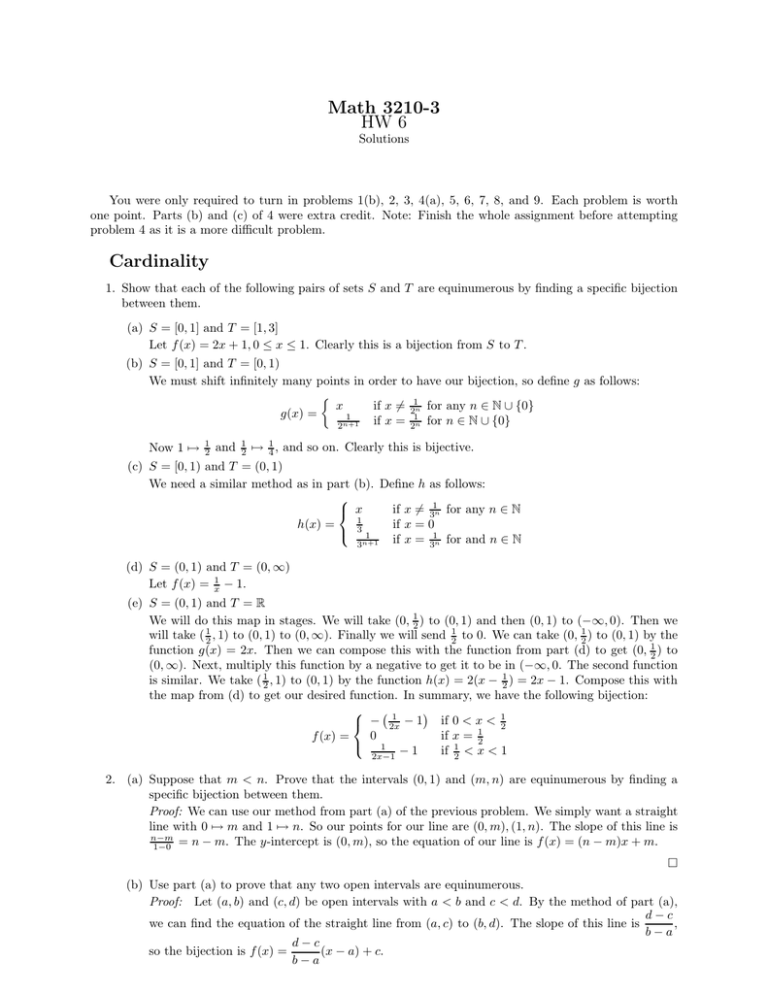
Math 3210-3
HW 6
Solutions
You were only required to turn in problems 1(b), 2, 3, 4(a), 5, 6, 7, 8, and 9. Each problem is worth
one point. Parts (b) and (c) of 4 were extra credit. Note: Finish the whole assignment before attempting
problem 4 as it is a more difficult problem.
Cardinality
1. Show that each of the following pairs of sets S and T are equinumerous by finding a specific bijection
between them.
(a) S = [0, 1] and T = [1, 3]
Let f (x) = 2x + 1, 0 ≤ x ≤ 1. Clearly this is a bijection from S to T .
(b) S = [0, 1] and T = [0, 1)
We must shift infinitely many points in order to have our bijection, so define g as follows:
x
if x 6= 21n for any n ∈ N ∪ {0}
g(x) =
1
if x = 21n for n ∈ N ∪ {0}
2n+1
Now 1 7→
1
2
and
1
2
7→ 41 , and so on. Clearly this is bijective.
(c) S = [0, 1) and T = (0, 1)
We need a similar method as in part (b). Define h as follows:
if x =
6 31n for any n ∈ N
x
1
if x = 0
h(x) =
31
if x = 31n for and n ∈ N
n+1
3
(d) S = (0, 1) and T = (0, ∞)
Let f (x) = x1 − 1.
(e) S = (0, 1) and T = R
We will do this map in stages. We will take (0, 12 ) to (0, 1) and then (0, 1) to (−∞, 0). Then we
will take ( 12 , 1) to (0, 1) to (0, ∞). Finally we will send 21 to 0. We can take (0, 21 ) to (0, 1) by the
function g(x) = 2x. Then we can compose this with the function from part (d) to get (0, 12 ) to
(0, ∞). Next, multiply this function by a negative to get it to be in (−∞, 0. The second function
is similar. We take ( 12 , 1) to (0, 1) by the function h(x) = 2(x − 21 ) = 2x − 1. Compose this with
the map from (d) to get our desired function. In summary, we have the following bijection:
1
− 1 if 0 < x < 12
− 2x
0
if x = 12
f (x) =
1
if 12 < x < 1
2x−1 − 1
2. (a) Suppose that m < n. Prove that the intervals (0, 1) and (m, n) are equinumerous by finding a
specific bijection between them.
Proof: We can use our method from part (a) of the previous problem. We simply want a straight
line with 0 7→ m and 1 7→ n. So our points for our line are (0, m), (1, n). The slope of this line is
n−m
1−0 = n − m. The y-intercept is (0, m), so the equation of our line is f (x) = (n − m)x + m.
˜
(b) Use part (a) to prove that any two open intervals are equinumerous.
Proof: Let (a, b) and (c, d) be open intervals with a < b and c < d. By the method of part (a),
d−c
,
we can find the equation of the straight line from (a, c) to (b, d). The slope of this line is
b−a
d−c
so the bijection is f (x) =
(x − a) + c.
b−a
˜
3. ♣ Prove: If (S r T ) ∼ (T r S), then S ∼ T .
Proof: Let f : S r T → T r S be a bijection. Define g : S → T by
f (x) if x ∈ S r T
g(x) =
x
if x ∈ S ∩ T
We need to show that g is bijective. Suppose g(x) = g(y). We have three cases to consider. First,
suppose x, y ∈ S r T . Then g(x) = f (x) = f (y) = g(y), so x = y since f is injective. Second, suppose
x, y ∈ S ∩ T . Then g(x) = x = y = g(y), so x = y since the identity function is injective. Finally,
suppose x ∈ S r T and y ∈ S ∩ T . Then g(x) = f (x) = y = g(y) implies that f (x) ∈ S ∩ T , a
contradiction since f (x) ∈ T r S. Therefore g is injective.
Now let t ∈ T . If t ∈ S ∩ T , then t ∈ S and g(t) = t. If t ∈ S r T , then ∃x ∈ S such that f (x) = t since
f is bijective. Therefore g is surjective. And we can conclude that g is in fact bijective. Therefore
S ∼ T.
˜
4. A real number is said to be algebraic if it is a root of a polynomial equation
an xn + · · · + a1 x + a0 = 0
with integer
Note that the algebraic numbers include the rationals and all roots of rationals
√ coefficients.
√
(such as 2, 3 5, etc.). If a number is not algebraic, it is called transendental.
(a) Show that the set of polynomials with integer coefficients is countable. (Hint: use the fact that
the countable union of countable sets is countable.)
We will begin this problem by proving a lemma.
Lemma 1
Let Zi = Z × Z × · · · × Z where there are i factors in the product. Then Zi is countable.
Proof: We will prove this by induction (something we will learn in the next section). Let i = 1.
Then Z1 = Z. Let f : Z → N be given by
2x
x≥0
f (x) =
−2x − 1 x < 0
By theorem 16, we must only show that f (x) is injective for Z to be countable. Suppose f (x) =
f (y). Then there are three cases to consider. Case 1: x, y ≥ 0. Then f (x) = 2x = 2y = f (y),
which implies that x = y. Case 2: x, y < 0, so f (x) = −2x − 1 = −2y − 1 = f (y), so x = y. And
/ Z,
Case 3: x ≥ 0 and y < 0. Then f (x) = 2x = −2y − 1 = f (y) which implies that x = −y − 12 ∈
so we have a contradiction. Therefore, f is injective, and Z is countable.
Now suppose that Zk is countable for some k ∈ N. Now we need to show that Zk+1 is countable.
But Zk+1 = Zk × Z. Since Zk and Z are countable, by an exercise we did in class, Zk+1 is
countable. Therefore, by induction, we know that Zi is countable for all i ∈ N.
˜
Now we will prove the homework problem.
Proof: Let A = the set of all polynomials with integer coefficients. Let Ai be the set of all
polynomials of degree i with integer coefficients. Then A = ∪Ai , which is a countable union. Let
hi : Ai → Zi+1 be given by hi (ai xi + ai−1 xi−1 + · · · + a1 x + a0 ) = (ai , ai−1 , . . . , a1 , a0 ). Clearly
hi is injective. By the lemma we just proved, Zi+1 is countable, so ∃fi+1 : Zi+1 → N which is
bijective. Define gi : Ai → N by gi (p) = fi+1 ◦ hi (p) for any p ∈ Ai . The composition of injective
functions is injective, as we proved in class, so Ai is countable for all i ∈ N. Finally, A is a
countable union of countable sets, so it is countable, by an exercise from class.
˜
(b) Show that the set of algebraic numbers is countable.
Proof: Let Ai be defined as above. Note that Ai is countable for all i ∈ N, so we can label all of
the polynomials in Ai as p1 , p2 , . . .. For and k ∈ N, pk ∈ Ai has at most i roots. (Note that we
don’t need finite roots, we just need countable roots, but finite is still countable.) Let r1 = roots
of p1 , r2 = roots of p2 , and so on. Now let Ri = ∪rj which are all of the roots of polynomials of
degree i. Ri is countable since it is the countable union of countable sets. Also note that there is
such an Ri for each Ai . Let R = ∪Ri . Then R is the set of all of the algebraic numbers, and it
is countable since it is the countable union of countable sets.
˜
(c) Are there more algebraic numbers or transcendental numbers?
Since there are uncountable many real numbers, and R = algebraic numbers ∪ transcendental
numbers, there must be more transcendental numbers then algebraic numbers.


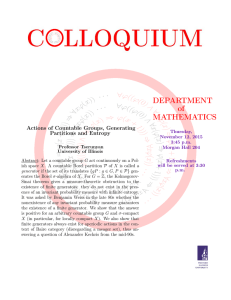
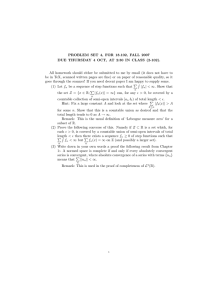
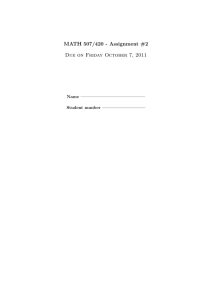
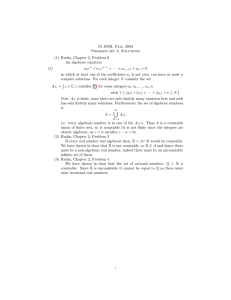
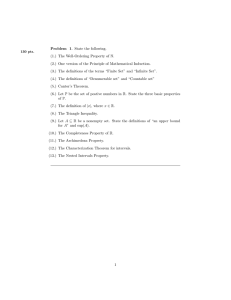
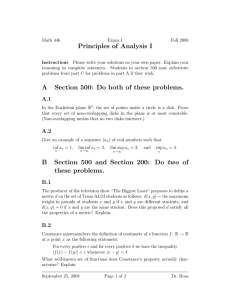
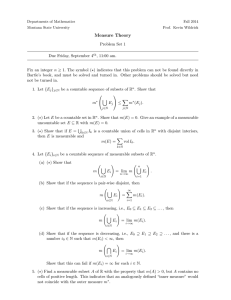
![MA2224 (Lebesgue integral) Tutorial sheet 7 [March 11, 2016] Name: Solutions R](http://s2.studylib.net/store/data/010730674_1-ca1a230eb5aca7dc4fc724de9a5a238d-300x300.png)